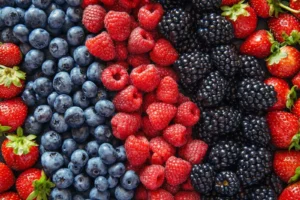Table of Contents
Anthocyanins: Powerful Antioxidants from Nature
Anthocyanins are one of over 6,000 types of flavonoid polyphenols found in plants. They not only give vibrant colors to many fruits and vegetables but also offer incredible health benefits. This article will explore anthocyanins in depth, from their definition and sources to their specific health benefits.

Anthocyanins: Powerful Antioxidants from Nature
What Are Anthocyanins?
Anthocyanins are a type of flavonoid, a family of powerful antioxidants that help combat aging and oxidative stress. To date, over 1,000 different anthocyanins have been identified. They are blue, purple, or red flavonoid pigments commonly found in plants.
The color of anthocyanins depends on the pH of their environment. This explains why the same food, such as eggplants or onions, can come in various shades.
Anthocyanins are not only beneficial to humans but also help protect plants from harmful factors like insects, UV rays, low temperatures, and drought.
Anthocyanin-Rich Foods
Anthocyanins are abundant in foods and beverages such as tea, honey, wine, fruits, vegetables, nuts, olive oil, and cocoa. Below is a list of anthocyanin-rich foods:
Fruits
- Berries: blueberries, strawberries, raspberries, cherries, pomegranates.
- Red and purple grapes, especially Concord grapes.
- Cherries and pomegranates (including their juices).
Vegetables
- Eggplants (especially the purple variety).
- Red cabbage, red onions.
- Purple sweet potatoes, purple and black carrots.
Note that beets, although purple, contain betalain pigments rather than anthocyanins. However, beets are still a highly nutritious food.
Health Benefits of Anthocyanins
Anthocyanins offer numerous health benefits due to their strong antioxidant and anti-inflammatory properties. Below are some of the key benefits:
1. Cardiovascular Protection
Research from the Iowa Women’s Health Study shows that women who consume anthocyanin-rich foods like strawberries and blueberries at least once a week have a significantly lower risk of cardiovascular disease.
2. Improved Immune Function
Anthocyanins help protect DNA, reduce inflammation, and boost cytokine production, thereby supporting the immune system.
3. Cancer Prevention
Anthocyanins can inhibit cancer cell growth and prevent tumor formation due to their antioxidant and anti-inflammatory properties.
4. Enhanced Cognitive Function
Studies suggest that anthocyanins can improve memory and neural function, especially in older adults.
5. Exercise Performance and Recovery
Anthocyanins help reduce fatigue and improve recovery after exercise due to their antioxidant properties.
6. Vision Protection
Anthocyanins enhance night vision and protect the eyes from free radical damage.
7. Anti-Inflammatory Effects
Anthocyanins have strong anti-inflammatory effects, helping to reduce markers of inflammation associated with chronic diseases.
8. Protection Against Type 2 Diabetes
Research from the National Institutes of Health shows that anthocyanin consumption reduces the risk of type 2 diabetes and improves blood sugar control.
9. Weight Management
Anthocyanins may aid in weight loss and improve metabolic health, especially when combined with a balanced diet and regular exercise.
10. Potential Protection Against Microplastics
Emerging research suggests that anthocyanins may help mitigate the harmful effects of microplastics due to their antioxidant and anti-inflammatory properties.
Anthocyanins vs. Anthocyanidins
Anthocyanins and anthocyanidins are subclasses of phenolic phytochemicals. While they share similar benefits, their chemical structures differ. Anthocyanins are glycosides, while anthocyanidins are aglycones. Both are used as natural dyes and have health-promoting properties.
Supplements and Dosage
While it’s best to obtain anthocyanins from food, supplements can be an alternative. Studies suggest that doses up to 640 mg per day are safe and may improve LDL cholesterol levels. However, always choose reputable brands to ensure quality and accuracy.
Uses in Ayurveda and Traditional Chinese Medicine (TCM)
In Ayurveda and TCM, anthocyanin-rich foods have been used for centuries to treat various ailments. For example, dark-colored foods are believed to support kidney health, improve circulation, and reduce inflammation.
Side Effects and Precautions
Anthocyanins are generally safe when consumed through food. However, supplements should be used with caution, as their quality and content can vary. Always consult a healthcare professional before starting any new supplement regimen.
Recipes to Incorporate Anthocyanins
Here are some delicious ways to include anthocyanin-rich foods in your diet:
- Make a berry smoothie for breakfast.
- Add red cabbage to salads or slaws.
- Roast purple sweet potatoes as a side dish.
- Snack on fresh cherries or grapes.
Conclusion
Anthocyanins are powerful antioxidants that offer numerous health benefits, from protecting the heart to improving cognitive function. By incorporating anthocyanin-rich foods into your diet, you can harness their natural healing properties and promote overall well-being.